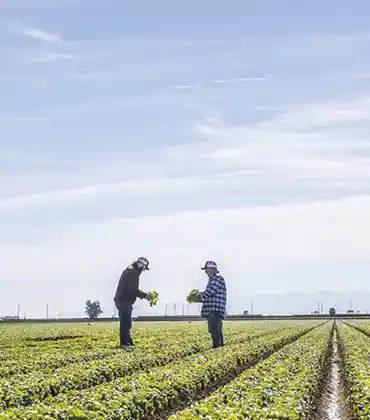THANK YOU FOR SUBSCRIBING
By Violeta Costa, Global Sustainability Manager, GB Foods
Tackling Food Waste: A Global Ethic Imperative
By Laurence COX, Sustainability Manager (UK Lead), Carlsberg Marston’s Brewing Company
An Artful Insight into Carlsberg Marston's Sustainable...
By Kasper Garnell, Brand Director, Joe & The Juice
How Joe & The Juice Are Taking App Ordering To The Next...
By Michael Ciepiela, Director, Food Safety and Quality Assurance, Taylor Farms
No Standard, No Problem -Setting Limits on Processes

 Julie Owst, Head of Sustainability and Change, Bidfood UK
Julie Owst, Head of Sustainability and Change, Bidfood UKIn my role at Bidfood, I’m often asked by customers about our net zero ambition which we’ve set for 2045. We’ve set about tackling emissions in our operations, but being a food business, most of our carbon footprint (92%) is driven by the food we buy, sourced globally via seasonally variable supply chains. I’m probably not alone in noticing the relative ease with which people in the corporate world toss around net zero target dates from the comfort of their desk (“oh, you’re going for 2045, why not 2030?” as I was asked recently!), but this approach is totally out of sync with the daunting task ahead of us. I applaud the ambition and the spirit behind ambitious targets; if I had a pound for every time I’d said “if we don’t set the ambition, we don’t have the context for action” I’d be a rich woman, but what concerns me is the disconnect between consumer expectations and the reality of decarbonising global food production.
Let’s start with data. The Paris Agreement’s goal of limiting global temperature increase to 1.5° above pre-industrial levels requires rapid and ambitious reductions in global greenhouse gas (GHG) emissions. It’s widely accepted that this can only be achieved if the energy, manufacturing, transport, construction, agriculture, and forestry sectors all drastically cut their emissions.
The focus of all climate talks is usually (and quite rightly) the urgent phasing out of fossil fuels, but even if fossil fuel emissions stopped now, current trends in global food systems (GFS)
would prevent us from staying within 1.5 °C target; they would threaten the achievement of the 2°C target by the end of the century. However, carbon budgets or net-zero emissions are often only discussed for CO2 emissions and not for other greenhouse gases, such as methane and nitrous oxide, in which GFS, especially agriculture production, are the main source (Source: Nature, 2022).There’s a lot more I could say about the other variables (a growing world population that needs feeding and the huge challenge of bringing a large chunk of that population out of severe food insecurity), suffice to say that cutting the emissions of food production sufficiently to bring us within reach of 1.5°C in a timeframe that’s hopefully within my lifetime is immense.
So, what can we do in the food industry? The first approach is to empower those buying food to make responsible choices. Bidfood are the first in the wholesale industry to be working with CarbonCloud, to harness the capability of AI to provide the carbon footprint of all our products within our range – this data should be available later in 2024. This is only the first step in our decarbonisation journey for the food we buy, but understanding the data can be a powerful catalyst for change. This empowering and enabling approach is advocated by Jon Alexander, in his book ‘Citizens’ – where he urges us to think of ourselves and others as active citizens, rather than just consumers, in the face of these challenges.
"Our commitment to carbon footprint data provision should also engage our suppliers to a greater extent in their own decarbonisation efforts."
The above will never be enough in isolation; it remains to be seen how, and to what extent, our customers will choose to use this data to try and drive behavioural change, and how their customers will respond to the provision of this information. It’s a pretty significant ‘unknown’, given our investment in the cause; research to date has shown that behaviour changes somewhat in response to carbon labelling,
but it’s a moving feast; demographics change and the climate crisis worsens, so we can expect responsiveness to increase accordingly.
Our commitment to carbon footprint data provision should also engage our suppliers to a greater extent in their own decarbonisation efforts. Suppliers will have the opportunity to differentiate lower carbon products in the marketplace, and also to gradually replace the relatively generic emissions data used in AI (artificial intelligence) calculations with supplier and product-specific data.
The world of carbon footprinting also needs to evolve to factor in carbon sequestration via more regenerative farming methods; I’ve written a blog about this for those who want to know more about this rapidly evolving area, but again, coming back to the data, the mitigating effects of regenerative systems won’t be enough alone; the continuation and growth of intensive livestock systems are likely, on food production’s current trajectory, to cause net GHG emissions to increase.
Given this context, one of the many interesting and perhaps unpredictable phenomena of 2023 has been the decline in plant-based meat alternatives (Source: Better wholesaling); an expected trend for 2024 is the growth of ‘clean label’ plant based options, in other words, eating more and ‘better’ plants (Source: Tasting the Future: Top 12 Sustainable Food Trends for 2024) – I’d suggest this is good news for budgets, gut health and creative chefs; vegetarian options are often some of the most creative and best-tasting on most menus.
So I think, as a food industry, we all have to look at our own role in trying to reduce the climate impacts of the food we buy and sell – not sit back and rely purely on those upstream in the value chain. Without taking greater responsibility, we can sit and debate the net zero target date all we like, but it will just be, if you forgive the pun, hot air.
Read Also















